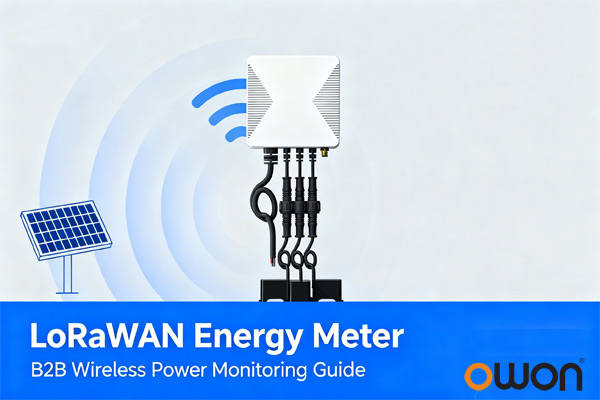For system integrators, OEM manufacturers, and utility distributors, choosing the right wireless metering technology can mean the difference between efficient operations and costly downtime. As the global smart metering market expands to $13.7 billion by 2024 , LoRaWAN energy meters have emerged as the preferred solution for long-range, low-power power monitoring. This guide breaks down their technical value, real-world applications, and how to select a B2B supplier that aligns with your OEM or integration needs.
1. Why LoRaWAN Energy Meters Dominate Industrial IoT Power Monitoring
The Technical Advantage of LoRaWAN for Energy Metering
Unlike WiFi or ZigBee, LoRaWAN (Long Range Wide Area Network) is engineered for the unique demands of energy monitoring:
- Extended Range: Communicates up to 10km in rural areas and 2km in urban/industrial environments , ideal for scattered assets like solar farms or manufacturing plants.
- Ultra-Low Power: Battery life exceeds 5 years (compared to 1–2 years for WiFi meters), slashing maintenance costs for remote sites.
- Interference Resistance: Spread-spectrum technology avoids signal disruption in high-electromagnetic environments (e.g., factories with heavy machinery).
- Global Compliance: Supports region-specific bands (EU868MHz, US915MHz, AS923MHz) with FCC/CE/ETSI certifications , critical for B2B cross-border deployment.
How LoRaWAN Meters Outperform Traditional Solutions
|
Metric
|
LoRaWAN Energy Meter
|
WiFi Energy Meter
|
Wired Meter
|
|
Deployment Cost
|
40% lower (no wiring)
|
Moderate
|
2x higher (labor/materials)
|
|
Data Range
|
Up to 10km
|
<100m
|
Limited by cabling
|
|
Battery Life
|
5+ years
|
1–2 years
|
N/A (grid-powered)
|
|
Industrial Suitability
|
High (IP65, -20~70℃)
|
Low (signal interference)
|
Medium (cable vulnerability)
|
2. Core Applications: Where LoRaWAN Power Meters Deliver ROI
LoRaWAN energy meters solve distinct pain points across B2B verticals—here’s how system integrators and OEMs are leveraging them:
① Industrial Sub-Metering
A Singapore semiconductor fab needed to monitor 100+ scattered production lines without disrupting 7×24 operations . Deploying LoRaWAN power meters with split-core CT clamps enabled non-intrusive installation, while gateways aggregated data to their SCADA system. Result: 18% energy reduction and $42k annual cost savings.
OWON Advantage: PC321 LORA energy meters support 0–800A current measurement with CT integration, ideal for high-load industrial sub-metering. Our OEM service allows custom branding and SCADA protocol compatibility (Modbus TCP/RTU).
② Distributed Solar & Storage
European solar integrators use bi-directional LoRaWAN electricity meters to track self-consumption and grid feed-in. The meters transmit real-time production data to cloud platforms, enabling dynamic load balancing. MarketsandMarkets reports 68% of solar OEMs prioritize LoRaWAN for off-grid systems .
OWON Advantage: PC321 LORA versions offer ±1% metering accuracy (Class 1) and support net metering, compatible with leading inverter brands (SMA, Fronius) for turnkey solar kits.
③ Commercial & Multi-Tenant Management
RV parks in North America rely on prepaid LoRaWAN power meters (US915MHz) to automate billing . Guests recharge via app, and meters remotely cut power for non-payment—reducing administrative work by 70%. For office buildings, sub-metering individual floors enables tenant cost allocation.
OWON Advantage: Our B2B clients customize PC321 meters with prepaid firmware and white-label apps, accelerating their time-to-market for smart building solutions.
④ Remote Utility Monitoring
Utilities in APAC (which represents 60% of global smart meter shipments ) use LoRaWAN meters to replace manual meter reading in rural areas. Each gateway manages 128+ meters, cutting operational costs by $15 per meter annually.
3. B2B Buyer’s Guide: Selecting a LoRaWAN Meter Supplier
Key Technical Specs to Verify
- Metering Capability: Ensure support for active/reactive energy (kWh/kvarh) and bi-directional measurement (critical for solar).
- Communication Flexibility: Look for dual-protocol options (LoRaWAN + RS485) for hybrid IT/OT environments .
- Durability: Industrial-grade IP65 enclosure and wide temperature range (-20~70℃) .
Why OEMs & Distributors Choose OWON
- Customization Expertise: Modify firmware (prepaid/postpaid modes), hardware (CT current range), and branding (logo, packaging) with 4-week lead times for bulk orders.
- Global Certification: PC321 LORA meters come pre-certified (FCC ID, CE RED), eliminating compliance delays for your B2B clients.
- Scalable Support: Our API integrates with 3rd-party platforms (Tuya, AWS IoT), and we provide technical documentation for your integration teams.
4. FAQ: Critical Questions for B2B Procurement
Q1: How do LoRaWAN meters handle data security for sensitive industrial data?
A: Reputable meters (like OWON PC321) use AES-128 encryption for data transmission and local storage. We also support private LoRaWAN networks (vs. public) for utilities and manufacturing clients needing end-to-end security.
Q2: Can we integrate your LoRaWAN meters into our existing IoT platform?
A: Yes—our meters support MQTT and Modbus TCP protocols, with sample code provided for common platforms (Azure IoT, IBM Watson). 90% of our OEM clients complete integration in <2 weeks.
Q3: What’s the minimum order quantity (MOQ) for OEM customization?
A: Our MOQ is 500 units for firmware/hardware tweaks, with volume discounts starting at 1,000 units. We also offer pre-production samples for your client testing.
Q4: How do region-specific frequency bands affect deployment?
A: We pre-configure meters for your target market (e.g., US915MHz for North America, EU868MHz for Europe). For multi-region distributors, our dual-band options reduce inventory complexity.
Q5: What maintenance is required for remote LoRaWAN meter fleets?
A: Our PC321 meters include OTA (over-the-air) firmware updates and remote diagnostics. Clients report <2% annual failure rates, with battery replacement only needed after 5+ years.
5. Next Steps for Your B2B LoRaWAN Project
Whether you’re an OEM building smart energy kits or a system integrator designing industrial monitoring solutions, OWON’s LORA energy meters deliver the reliability and customization your clients demand.
- For Distributors: Request our wholesale price list and certification package to expand your IoT product portfolio.
- For OEMs: Schedule a technical demo to test PC321 integration with your platform and discuss customization.
- For System Integrators: Download our case study on industrial sub-metering to share with your clients.
Contact our B2B team today to accelerate your LoRaWAN energy monitoring projects.
Post time: Oct-14-2025
